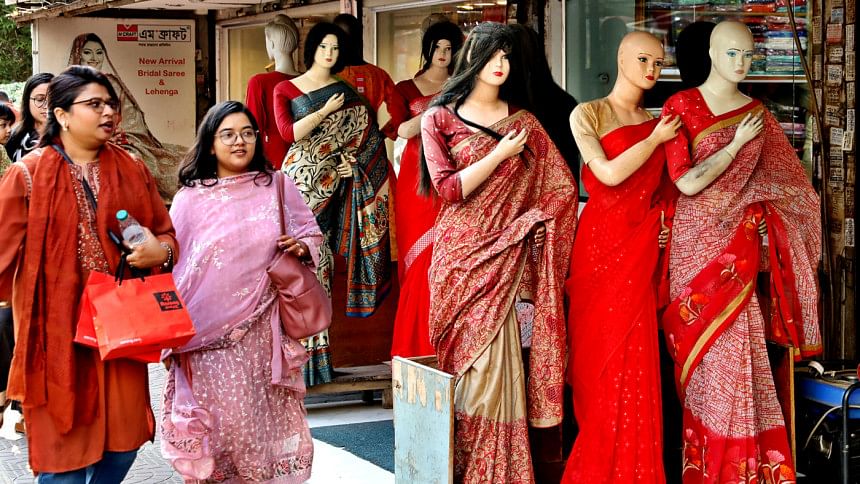Pahela Baishakh sales better this year

With Pahela Baishakh just around the corner, a festive spirit has taken over markets across Bangladesh, with clothing, sweetmeats and fish registering noticeably higher sales compared to last year.
Businesspeople say that last year, Pahela Baishakh fell just two days after Eid-ul-Fitr, while this year, the two festivals are nearly two weeks apart. This gap has had a somewhat positive impact on sales.
However, they added that sales would have been even better this year if people could have anticipated the scale of celebrations to take place following last year's nationwide protests culminating in a political changeover.
The celebration of the beginning of a new Bengali year traces its roots back to the Mughal era, when Emperor Akbar introduced tax collection reforms in the region.
In previous years, Baishakh celebrations and the purchase of new dresses accounted for an estimated one-fourth of annual sales by local fashion outlets.
Soumik Das, chief executive officer of Rang Bangladesh, told The Daily Star that sales centred around Pahela Baishakh have been significantly better this year.
"Last year, Pahela Baishakh came just two days after Eid-ul-Fitr, but this time there's a gap between the two festivals, which has positively impacted sales," he said.
Compared to last year, his sales have increased by nearly 10 percent.
However, due to the short time after Eid-ul-Fitr, full preparations for Pahela Baishakh could not be made. As a result, despite receiving inquiries from many customers, it was not possible to respond to all of them, he added.
Khalid Mahmood Khan, co-founder of Kay Kraft, a retailer of fashionwear, accessories, home textiles, handicrafts, and handloom-based products, said sales have improved compared to last year.
But despite extensive preparations, the sales figures have fallen short of expectations, he said.
He attributed this to a sense of uncertainty among the public and institutions regarding the scale of this year's celebrations.
Shaheen Ahmed, the owner of Anjan's -- a well-known fashion and lifestyle brand in Bangladesh offering a wide range of clothing, accessories, and lifestyle products -- echoed Khan.
SaRa Lifestyle Limited, a sister concern of leading garment exporter Snowtex Group, has rolled out a summer collection designed specifically with the hot weather during Pahela Baishakh in mind.
Sk Rahat Auyon, manager of media and public relations at Snowtex Group, said the response has been encouraging.
"Sales are going quite well. With Eid and Pahela Baishakh falling close together this year, many customers chose to buy their Baishakh outfits during Eid shopping," he said.
According to a 2012 survey by the Bangladesh Fashion Entrepreneurs Association, a platform for local clothing entrepreneurs, fashion houses across the country generate annual sales of around Tk 6,000 crore.
More than 50 percent of the sales come during Eid-ul-Fitr, and at least another 25 percent ahead of Pahela Baishakh, said the survey, which was conducted in 2012.
Celebration of the new Bengali year has also become one of the biggest occasions for sweetmeat makers thanks to a growing trend among corporates to send gift hampers to clients and vendors.
Sweets are an integral part of Baishakh celebrations, with items worth around Tk 50 crore sold across Bangladesh each year before the pandemic hit in 2020.
Mahbubur Rahman Bokul, head of Bangladesh operations at Premium Sweets, said sales centring this year's Pahela Baishakh have increased by 5 percent compared to last year.
"In 2024, Pahela Baishakh was just two days after Eid, whereas this year the gap is nearly two weeks. This has had a positive impact on sales," he said.
However, Bokul said that sales could have been even better if the overall situation in the country was more stable.
Over time, a plate of panta (water-soaked rice) with mashed potato and a piece of fried hilsa has become a must for Baishakh breakfast, marking the start of daylong celebrations. The demand for hilsa, already a pricier national fish, typically drives prices up every year.
Fish traders say hilsa prices have risen slightly further this year amid a supply crunch, while demand remains high.
Khokon Chandra Samaddar, a wholesale fish trader at Jatrabari fish market in Dhaka, said hilsa prices increased by Tk 250-300 per kilogramme (kg) over the past week due to Pahela Baishakh.
At Karwan Bazar, one of the largest kitchen markets in the capital, Sukkur Ali has been selling hilsa weighing between 1 and 1.5 kg for Tk 1,800 to Tk 2,200 per kg.
However, larger fresh hilsa, weighing 1 to 1.5 kg, is difficult to find, he added.
Currently, fish weighing 450 to 500 grammes are selling for Tk 1,400 per kg, while those weighing between 550 and 650 grammes are priced at Tk 1,700 to Tk 1,800 per kg.
Smaller fresh hilsa, weighing between 300 and 400 grammes, are more commonly found in Dhaka markets and are priced between Tk 800 and Tk 1,000 per kg.
Ali said cold-stored hilsa is not the first choice for customers as most prefer a fresh catch.

 For all latest news, follow The Daily Star's Google News channel.
For all latest news, follow The Daily Star's Google News channel. 



Comments